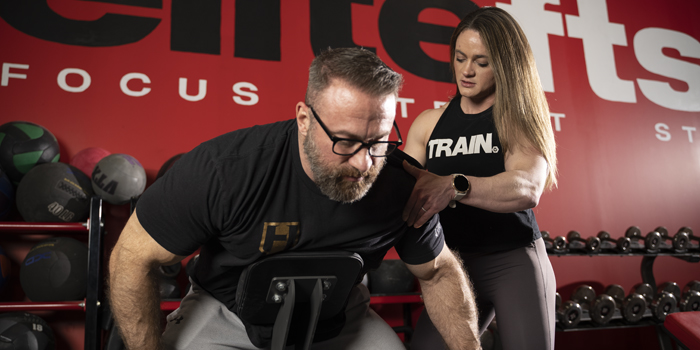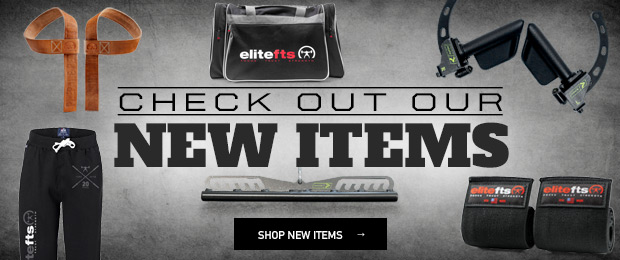
I wrote about the utility of the cross-body cable extension last year in the context of a hypertrophy movement that can cover the bases of rehab—a kill-two-birds-with-one-stone scenario. Yet, I continue to see execution errors.
The movement in and of itself has enormous potential to address a myriad of shoulder and upper back issues, which are also nasty contributors to elbow and forearm issues.
Cross-body Cable Extension Errors
Especially in shoulder and elbow pain, the ability to control upper back and ribcage positions can be incredibly powerful. I've gotten quite a few emails lately asking specifically about elbow pain. More often than not, one of the places I start treating elbow pain is the root cause. I look at the relative torque demand of the shoulder and how it sits. The elbow is very often at the mercy of how well the humerus (shoulder/upper arm) sits and rotates and what the wrist is doing (often holding weight and doing so in a mechanism that attempts to accommodate for whatever is happening at the shoulder).
Just as the hip bone orientation influences hip rotation, the position of the shoulder blade (and how stable it is) plays a tremendous role in the rotational demand of the humerus. Stability will always precede force production, so when someone tells me they have limited output from a press, one of the first things I consider is stability.
I filmed a video below, with simple and more complex cues and applications.
YouTube
It's important to note that a few key concepts make this movement so effective.
From a basic anatomy standpoint, the long head of the tricep attaches to the shoulder blade, which is part of why upper back and shoulder blade control is so important.
On a more complex level, the ability of the shoulder blade to sit on a ribcage is also heavily influenced by the ribcage position. Consider which direction it orients to at baseline and which direction is better at rotating towards or away.
Correct Execution of the Cross-body Cable Extension
Most people will get a LOT of bang for their buck with just correct execution of the basics outlined in the video:
Keep the Upper Back Set
Your upper and mid back should be "set" to control the shoulder blade. This should provide a more stable surface for the tricep to operate.
Engage the Rear Delt
The rear delt should also be engaged intentionally to allow more improved proprioception in the posterior musculature. One of the biggest issues I work on with people is how proprioceptively "aware" we are of all the muscles on the front half of our body. Think about all the pressing we do and the fact that most of our life is spent facing forwards. Life in "front" of us is what we are more naturally attuned to.
Maintain Position
Rather than allowing the shoulder to dump forward, roll forward, or "fixate" close to our body by hyper-recruitment of anterior delts and traps, keep your upper arm in direct alignment with the direction of the cable.
Keep your arm away from your body to promote parallel alignment of the muscle fibers you're working with the cable. Keep your upper arm in line with your body (or slightly behind) rather than allowing it to drift forward.
It's very, VERY simple if you can visualize the system of levers and pulleys.
On a more complex level, because I have worked on my husband extensively and know his patterns pretty well, I could look more directly at the pattern of torque or torsion he accesses more readily at the moment.
The utility of the diaphragm for bracing has become very popular. Still, the power of respiration to influence "buoyancy" through the shoulder and ribcage needs to be talked about. Inherently, we aren't built symmetrically and tend to bias certain positions or holding patterns.
My husband Dave fits into a pattern I see fairly frequently—limited shoulder internal rotation at 90 degrees abduction with a first capsular and second "bony" end feel in his range of motion. Moreover, the difference at the point in the range of motion where I first start to feel a capsular restriction versus where the end feel becomes more joint/bone oriented is relatively small. There's not a lot of distance between the two, which leads me to want to bias my treatment of him (and his movement selections in training) to address the scapular position on top of the ribcage.
Again, knowing him and looking at landmarks of his sternum, the lower borders of his anterior ribcage, the infrasternal angle or where his two sides of the ribcage come together, and which direction it "likes" to face, I already had an idea of where we needed to go. After watching Dave's training videos regarding shoulder position and stability, elbow, and wrist position (small cues like which direction his wrist biases), I wanted to start by looking at his ribcage.
RELATED: Intensity Techniques to Use in a Rehab Block
Realize, he's also dealing with a small TFL tear or strain, secondary to a change in position with his lower body movements. Having tested him at home before training and being with him every lower body training day, I saw consistency between what was happening with his upper and lower body, with his ribcage acting as the connecting "indicator" in between.
Dave has a hard time orienting his pelvis to the left. He prefers a right-lateralized/oriented holding pattern (modifying the relationship of the relative internal and external rotation of the femur), and his upper ribcage and shoulders tend to orient back toward midline.
In the video, you can see his sternum tilt or deviate as well. There are so many layers I could "look at" and peel apart. Still, my job as a clinician, coach, and training partner isn't to pick apart layers to sound more intelligent. My role is to give him the simplest solution possible to improve his situation.
In his case, I needed to allow the right upper back and ribcage to rotate appropriately, with a bonus of allowing his center of mass to shift slightly left.
If you pause the video, you'll see the position I have him in actually emulates the gait cycle. It isn't surprising, given all the cardio and walking we're doing now during bodybuilding prep.
This is a VERY broad explanation. There are a number of layers that could be picked apart, but this is a fantastic demonstration of the fact that a movement can be as simple or complicated as we want to make it.
I didn't cue Dave perfectly or get into the nitty gritty (waiting for the Internet warriors to crucify me for not perfecting his position) but it was good enough that I was fairly confident that we hit on what needed to happen.
Through demonstration, he:
- Shifts back and over his left leg to facilitate his left adductor (I wasn't planning on this, but it was a HUGE bonus).
- Allows his right upper back to "set" where we wanted it to.
- Promotes airflow into the right upper chest wall and provides buoyancy for improved mechanical advantage of the mid and low trap.
- Improves tricep stability and function to assist in "anchoring" his shoulder blade on a ribcage.
The re-test of ROM at the end of the video was a bonus. I was hoping to get the change we did but wasn't sure. The point I wanted to make was that small changes to the execution of very simple movements can make a dramatic difference in how effective the movement is.
He'll be hitting what he needs to for hypertrophy for stage, especially as arm size and triceps are one of the things he needs to bring up. He'll be doing it in a way that leaves him BETTER, provides a better output on his main movements (leading to increased size, strength, and explosiveness), and keeps him healthier.
Conclusion
The person who makes the most progress over the long run will almost always be the person who can stay the healthiest. So, hitting 3/3 above is about as good as it gets.
SMART movement selection coupled with curious, intentional execution CAN serve as your training and rehab.
As a whole, it's important to remember that the best solution is the simplest one the athlete can best execute. MOST people will get plenty of bang for their buck with the surface-level improved execution.
Dani is a Doctor of Physical therapy, CSCS, nationally qualified women’s physique competitor, and elite level powerlifter in the 123 class. She's the first to admit she pushes the envelope with training, which Dani is a Doctor of Physical therapy, CSCS, nationally qualified women’s physique competitor, and elite level powerlifter in the 123 class. She's the first to admit she pushes the envelope with training, which uniquely allows her to blend principles of rehab with a love for all things iron. Creativity, relationships, and trust drive her to empower coaches and athletes with tools and education from a PT who understands training demands. Visit MERGE Performance to learn more (remote PT services, consults, and training).











